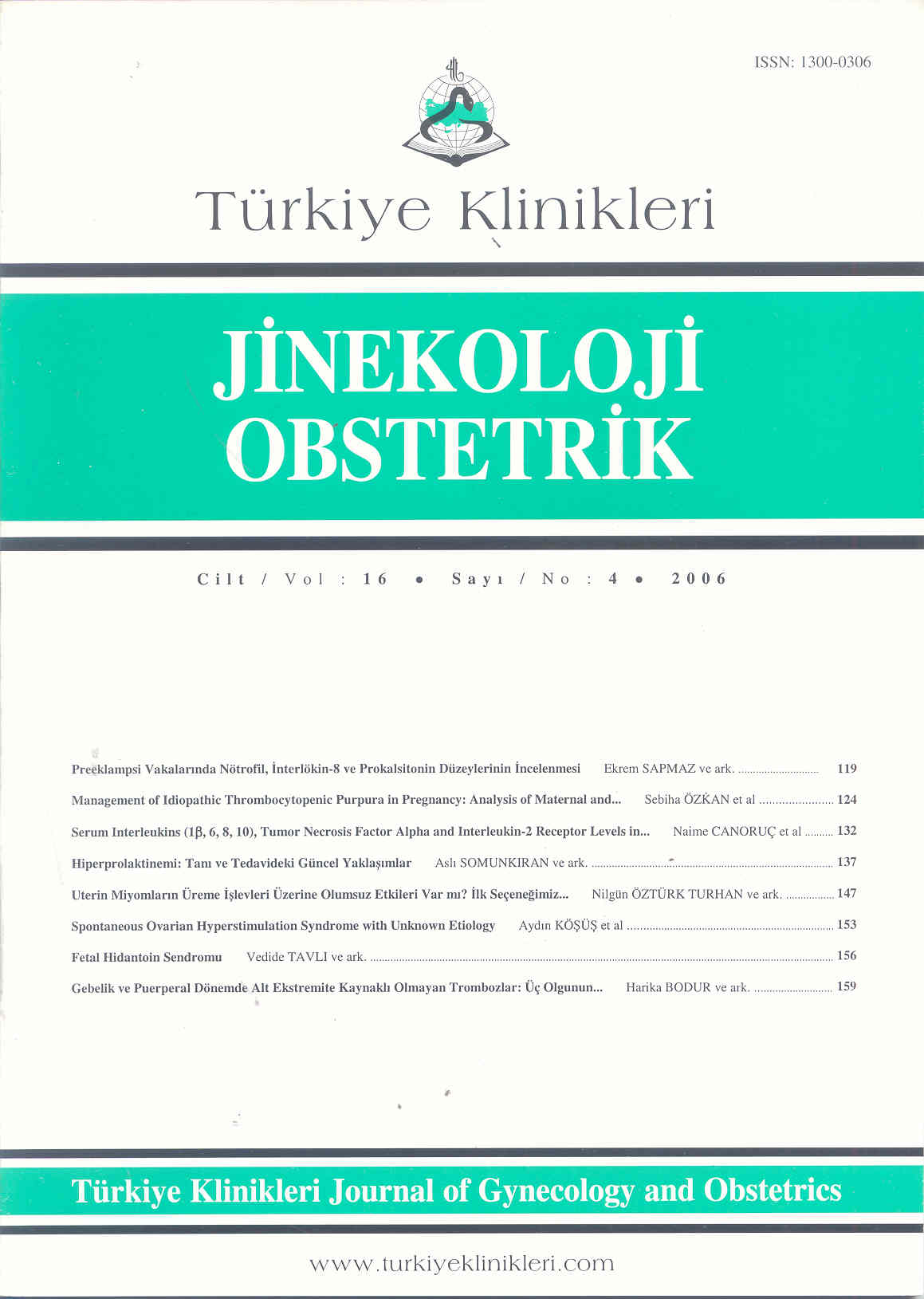Open Access
Peer Reviewed
REVIEW
3325 Viewed1255 Downloaded
Does Uterine Myomas Have Adverse Effects On Reproductive Outcome? Should Infertility Treatment Or Myomectomy Be The First Choice Of Therapy?
Uterin Miyomların Üreme İşlevleri Üzerine Olumsuz Etkileri Var mı? İlk Seçeneğimiz İnfertilite Tedavisi mi Yoksa Miyomektomi mi Olmalı?
Turkiye Klinikleri J Gynecol Obst. 2006;16(4):147-52
Article Language: TR
Copyright Ⓒ 2025 by Türkiye Klinikleri. This is an open access article under the CC BY-NC-ND license (http://creativecommons.org/licenses/by-nc-nd/4.0/)
ÖZET
İnfertil kadınların yaklaşık olarak %5-10'unda bulunan miyomlar %1-2.4 hastada tek başına infertilite nedeni olabilmektedir. Miyomun implantasyon ve gebelik oranları üzerine olan etkileri retrospektif ve prospektif bir çok çalışmada araştırılmıştır. Ancak yardımcı üreme teknikleri öncesinde ne zaman hangi boyut ve lokalizasyondaki miyomların çıkarılması gerektiğinin cevabı halen tartışmalıdır ve önce infertilite tedavisi mi yoksa miyomektomi mi yapılması gerektiği konusuna açıklık getirilememiştir. Miyomların, sadece submukozal, endometriuma bası yapan ve büyük olanları tüp bebek sonuçlarını olumsuz etkiler ve tüp bebek tedavisi öncesi çıkarılmaları gerekmektedir. Subserozal miyomların üreme işlevleri üzerine olumsuz etkisi yoktur ve operasyon gerekmez. Uterin boşluğu yaylandırmayan intramural miyomların, üreme sonuçları üzerine etkilerini açıklamak daha zordur. Endometrial boşluğu normal olan küçük-orta büyüklükte intramural miyomların tüp bebek sonuçlarına etkisi kesin olmadığı için, elde yeterli çalışmalar olmadığı sürece, bütün intramural miyomlar için koruyucu amaçla miyomektomi yapılması tavsiye edilemez. Küçük intramural miyomları olan hastalarda iyi ovaryan cevap, kaliteli embriyoya rağmen tekrarlayan tüp bebek başarısızlıkları veya erken gebelik kayıpları mevcutsa yeni bir tüp bebek girişiminden önce miyomektomi düşünülebilir.
İnfertil kadınların yaklaşık olarak %5-10'unda bulunan miyomlar %1-2.4 hastada tek başına infertilite nedeni olabilmektedir. Miyomun implantasyon ve gebelik oranları üzerine olan etkileri retrospektif ve prospektif bir çok çalışmada araştırılmıştır. Ancak yardımcı üreme teknikleri öncesinde ne zaman hangi boyut ve lokalizasyondaki miyomların çıkarılması gerektiğinin cevabı halen tartışmalıdır ve önce infertilite tedavisi mi yoksa miyomektomi mi yapılması gerektiği konusuna açıklık getirilememiştir. Miyomların, sadece submukozal, endometriuma bası yapan ve büyük olanları tüp bebek sonuçlarını olumsuz etkiler ve tüp bebek tedavisi öncesi çıkarılmaları gerekmektedir. Subserozal miyomların üreme işlevleri üzerine olumsuz etkisi yoktur ve operasyon gerekmez. Uterin boşluğu yaylandırmayan intramural miyomların, üreme sonuçları üzerine etkilerini açıklamak daha zordur. Endometrial boşluğu normal olan küçük-orta büyüklükte intramural miyomların tüp bebek sonuçlarına etkisi kesin olmadığı için, elde yeterli çalışmalar olmadığı sürece, bütün intramural miyomlar için koruyucu amaçla miyomektomi yapılması tavsiye edilemez. Küçük intramural miyomları olan hastalarda iyi ovaryan cevap, kaliteli embriyoya rağmen tekrarlayan tüp bebek başarısızlıkları veya erken gebelik kayıpları mevcutsa yeni bir tüp bebek girişiminden önce miyomektomi düşünülebilir.
ANAHTAR KELİMELER: Miyom, infertilite
ABSTRACT
Uterine myomas are associated with infertility in 5% to 10% of cases and are the sole cause of infertility in only 1%-2.4% of cases when all of the other factors of infertility have been excluded. The role of myomas on implantation and reproductive outcomes have been investigated in many prospective and retrospective studies. However, the answers to questions that when and which size and location of miyomas should be removed before assisted reproductive techniques and whether myomectomy or infertility therapy comes first still remain a subject of debate and whether myomectomy or infertility therapy comes first has not clearly been determined. Only those myomas with a submucosal or an intracavitary component and large myomas are associated with decreased reproductive outcomes and should be removed before assisted reproductive techniques. Subserosal myomas have no impact on reproductive outcomes and need not to be operated. It's more difficult to explain the effects of intramural myomas on reproductive outcomes which does not distort the uterine cavity. Because the impact of small-moderate sized intramural myomas without intracavitary component on in vitro fertilization (IVF) outcomes is not clear, as long as adequate studies are not made, the recommendation of routine prophylactic myomectomy is difficult. In patients with small myomas with recurrent IVF failures in spite of good ovarian response and qualified embryos or early pregnancy failure, myomectomy prior to additional IVF cycles might be considered.
Uterine myomas are associated with infertility in 5% to 10% of cases and are the sole cause of infertility in only 1%-2.4% of cases when all of the other factors of infertility have been excluded. The role of myomas on implantation and reproductive outcomes have been investigated in many prospective and retrospective studies. However, the answers to questions that when and which size and location of miyomas should be removed before assisted reproductive techniques and whether myomectomy or infertility therapy comes first still remain a subject of debate and whether myomectomy or infertility therapy comes first has not clearly been determined. Only those myomas with a submucosal or an intracavitary component and large myomas are associated with decreased reproductive outcomes and should be removed before assisted reproductive techniques. Subserosal myomas have no impact on reproductive outcomes and need not to be operated. It's more difficult to explain the effects of intramural myomas on reproductive outcomes which does not distort the uterine cavity. Because the impact of small-moderate sized intramural myomas without intracavitary component on in vitro fertilization (IVF) outcomes is not clear, as long as adequate studies are not made, the recommendation of routine prophylactic myomectomy is difficult. In patients with small myomas with recurrent IVF failures in spite of good ovarian response and qualified embryos or early pregnancy failure, myomectomy prior to additional IVF cycles might be considered.
MENU
POPULAR ARTICLES
MOST DOWNLOADED ARTICLES





This journal is licensed under a Creative Commons Attribution-NonCommercial-NoDerivatives 4.0 International License.










